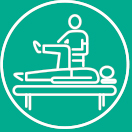
No one wants to live in pain. But no one should put their health at risk in an effort to be pain free. Since 1999, Americans have increasingly been prescribed opioids- painkillers like Vicodin, OxyContin, Opana, and methadone, and combination drugs like Percocet. In some situations prescription opioids are an appropriate part of medical treatment. However, some risks to opioid use include depression, overdose, addiction and withdrawal symptoms. In addition, people addicted to prescription opioids are 40 times more likely to become addicted to heroin.
The Center for Disease Control and Prevention (CDC) is urging healthcare providers to reduce the use of opioids in favor of safe alternatives like physical therapy. The American Physical Therapy Association cites these four ways that physical therapists help patients manage pain.

EXERCISE: A study that followed 20,000 people for 11 years found that those who exercised on a regular basis experienced less pain. Among those who exercised more than three times per week, chronic widespread pain was 28 percent less common.

MANUAL THERAPY: Research supports a hands-on approach to treating pain, with physical therapy strategies including manipulation, joint and soft tissue mobilizations, and dry needling. From carpal tunnel syndrome to low back pain, this type of care can reduce pain and improve movement.

EDUCATION: A large study conducted with military personnel demonstrated that those with back pain who received a 45-minute educational session about pain were less likely to seek treatment than their peers who didn’t receive education about pain. Physical therapists make sure patients understand their pain histories and help set realistic expectations for treatment.

TEAMWORK: Studies have shown that developing a positive relationship with a physical therapist and being an active participant in recovery can positively affect patients’ outcomes. Physical therapists work directly with patients and assess how pain responds to treatment.
Source: moveforwardpt.com
Download full infographic:

